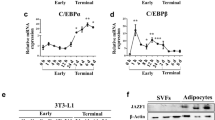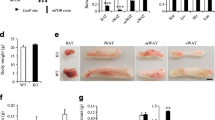Abstract
Aims/hypothesis
The growing obesity epidemic necessitates a better understanding of adipocyte biology and its role in metabolism. The Janus kinase (JAK)–signal transducer and activator of transcription (STAT) pathway mediates signalling by numerous cytokines and hormones that regulate adipocyte function, illustrating the physiological importance of adipose JAK–STAT. The aim of this study was to investigate potential roles of adipocyte JAK2, an essential player in the JAK–STAT pathway, in adipocyte biology and metabolism.
Methods
We generated adipocyte-specific Jak2 knockout (A-Jak2 KO) mice using the Cre-loxP system with Cre expression driven by the Ap2 (also known as Fabp4) promoter.
Results
Starting at 2–3 months of age, male and female A-Jak2 KO mice gradually gained more body weight than control littermates primarily due to increased adiposity. This was associated with reduced energy expenditure in A-Jak2 KO mice. In perigonadal adipose tissue, the expression of numerous genes involved in lipid metabolism was differentially regulated. In addition, adipose tissue from A-Jak2 KO mice displayed impaired lipolysis in response to isoprenaline, growth hormone and leptin stimulation, suggesting that adipose JAK2 directly modulates the lipolytic program. Impaired lipid homeostasis was also associated with disrupted adipokine secretion. Accordingly, while glucose metabolism was normal at 2 months of age, by 5–6 months of age, A-Jak2 KO mice had whole-body insulin resistance.
Conclusions/interpretation
Our results suggest that adipocyte JAK2 plays a critical role in the regulation of adipocyte biology and whole-body metabolism. Targeting of the JAK–STAT pathway could be a novel therapeutic option for the treatment of obesity and type 2 diabetes.






Similar content being viewed by others
Abbreviations
- A-Jak2 KO:
-
Adipocyte-specific Jak2 knockout
- AP2:
-
Adipocyte protein 2
- CNTF:
-
Ciliary neurotrophic factor
- GH:
-
Growth hormone
- GHR:
-
GH receptor
- GTT:
-
Glucose tolerance test
- ITT:
-
Insulin tolerance test
- JAK:
-
Janus kinase
- LIF:
-
Leukaemia inhibitory factor
- OSM:
-
Oncostatin M
- RER:
-
Respiratory exchange ratio
- STAT:
-
Signal transducer and activator of transcription
- \( \overset{\cdotp }{V}{\mathrm{O}}_2 \) :
-
Volume of oxygen consumption
References
Sun K, Kusminski CM, Scherer PE (2011) Adipose tissue remodeling and obesity. J Clin Invest 121:2094–2101
Guilherme A, Virbasius JV, Puri V, Czech MP (2008) Adipocyte dysfunctions linking obesity to insulin resistance and type 2 diabetes. Nat Rev Mol Cell Biol 9:367–377
Kahn BB, Flier JS (2000) Obesity and insulin resistance. J Clin Invest 106:473–481
Swinburn BA, Sacks G, Hall KD et al (2011) The global obesity pandemic: shaped by global drivers and local environments. Lancet 378:804–814
Richard AJ, Stephens JM (2011) Emerging roles of JAK–STAT signaling pathways in adipocytes. Trends Endocrinol Metab 22:325–332
Shi SY, Garcia Martin R, Duncan RE et al (2012) Hepatocyte-specific deletion of Janus kinase 2 (JAK2) protects against diet-induced steatohepatitis and glucose intolerance. J Biol Chem 287:10277–10288
Sos BC, Harris C, Nordstrom SM et al (2011) Abrogation of growth hormone secretion rescues fatty liver in mice with hepatocyte-specific deletion of JAK2. J Clin Invest 121:1412–1423
Stewart WC, Morrison RF, Young SL, Stephens JM (1999) Regulation of signal transducers and activators of transcription (STATs) by effectors of adipogenesis: coordinate regulation of STATs 1, 5A, and 5B with peroxisome proliferator-activated receptor-gamma and C/AAAT enhancer binding protein-alpha. Biochim Biophys Acta 1452:188–196
Hellgren G, Albertsson-Wikland K, Billig H, Carlsson LM, Carlsson B (2001) Growth hormone receptor interaction with Jak proteins differs between tissues. J Interferon Cytokine Res 21:75–83
Gomez-Ambrosi J, Catalan V, Diez-Caballero A et al (2004) Gene expression profile of omental adipose tissue in human obesity. FASEB J 18:215–217
Zhang K, Guo W, Yang Y, Wu J (2011) JAK2/STAT3 pathway is involved in the early stage of adipogenesis through regulating C/EBPbeta transcription. J Cell Biochem 112:488–497
Yarwood SJ, Sale EM, Sale GJ, Houslay MD, Kilgour E, Anderson NG (1999) Growth hormone-dependent differentiation of 3T3-F442A preadipocytes requires Janus kinase/signal transducer and activator of transcription but not mitogen-activated protein kinase or p70 S6 kinase signaling. J Biol Chem 274:8662–8668
Floyd ZE, Stephens JM (2003) STAT5A promotes adipogenesis in nonprecursor cells and associates with the glucocorticoid receptor during adipocyte differentiation. Diabetes 52:308–314
Shang CA, Waters MJ (2003) Constitutively active signal transducer and activator of transcription 5 can replace the requirement for growth hormone in adipogenesis of 3T3-F442A preadipocytes. Mol Endocrinol 17:2494–2508
Nanbu-Wakao R, Morikawa Y, Matsumura I et al (2002) Stimulation of 3T3-L1 adipogenesis by signal transducer and activator of transcription 5. Mol Endocrinol 16:1565–1576
Siegrist-Kaiser CA, Pauli V, Juge-Aubry CE et al (1997) Direct effects of leptin on brown and white adipose tissue. J Clin Invest 100:2858–2864
Trujillo ME, Sullivan S, Harten I, Schneider SH, Greenberg AS, Fried SK (2004) Interleukin-6 regulates human adipose tissue lipid metabolism and leptin production in vitro. J Clin Endocrinol Metab 89:5577–5582
van Hall G, Steensberg A, Sacchetti M et al (2003) Interleukin-6 stimulates lipolysis and fat oxidation in humans. J Clin Endocrinol Metab 88:3005–3010
Memon RA, Feingold KR, Moser AH, Doerrler W, Grunfeld C (1992) In vivo effects of interferon-alpha and interferon-gamma on lipolysis and ketogenesis. Endocrinology 131:1695–1702
Goodman HM (1968) Multiple effects of growth hormone on lipolysis. Endocrinology 83:300–308
Fielder PJ, Talamantes F (1987) The lipolytic effects of mouse placental lactogen II, mouse prolactin, and mouse growth hormone on adipose tissue from virgin and pregnant mice. Endocrinology 121:493–497
Buettner C, Muse ED, Cheng A et al (2008) Leptin controls adipose tissue lipogenesis via central, STAT3-independent mechanisms. Nat Med 14:667–675
Zvonic S, Cornelius P, Stewart WC, Mynatt RL, Stephens JM (2003) The regulation and activation of ciliary neurotrophic factor signaling proteins in adipocytes. J Biol Chem 278:2228–2235
Hogan JC, Stephens JM (2005) Effects of leukemia inhibitory factor on 3T3-L1 adipocytes. J Endocrinol 185:485–496
Ott V, Fasshauer M, Dalski A, Klein HH, Klein J (2002) Direct effects of ciliary neurotrophic factor on brown adipocytes: evidence for a role in peripheral regulation of energy homeostasis. J Endocrinol 173:R1–R8
Song HY, Kim MR, Lee MJ et al (2007) Oncostatin M decreases adiponectin expression and induces dedifferentiation of adipocytes by JAK3- and MEK-dependent pathways. Int J Biochem Cell Biol 39:439–449
Thompson BR, Mazurkiewicz-Munoz AM, Suttles J, Carter-Su C, Bernlohr DA (2009) Interaction of adipocyte fatty acid-binding protein (AFABP) and JAK2: AFABP/aP2 as a regulator of JAK2 signaling. J Biol Chem 284:13473–13480
Nordstrom SM, Tran JL, Sos BC, Wagner KU, Weiss EJ (2013) Disruption of JAK2 in adipocytes impairs lipolysis and improves fatty liver in mice with elevated GH. Mol Endocrinol 27:1333–1342
Krempler A, Qi Y, Triplett AA, Zhu J, Rui H, Wagner KU (2004) Generation of a conditional knockout allele for the Janus kinase 2 (Jak2) gene in mice. Genesis 40:52–57
Wagner KU, Krempler A, Triplett AA et al (2004) Impaired alveologenesis and maintenance of secretory mammary epithelial cells in Jak2 conditional knockout mice. Mol Cell Biol 24:5510–5520
Lemonnier D (1972) Effect of age, sex, and sites on the cellularity of the adipose tissue in mice and rats rendered obese by a high-fat diet. J Clin Invest 51:2907–2915
Choi D, Schroer SA, Lu SY et al (2010) Erythropoietin protects against diabetes through direct effects on pancreatic beta cells. J Exp Med 207:2831–2842
Bluher M, Michael MD, Peroni OD et al (2002) Adipose tissue selective insulin receptor knockout protects against obesity and obesity-related glucose intolerance. Dev Cell 3:25–38
He W, Barak Y, Hevener A et al (2003) Adipose-specific peroxisome proliferator-activated receptor gamma knockout causes insulin resistance in fat and liver but not in muscle. Proc Natl Acad Sci U S A 100:15712–15717
Urs S, Harrington A, Liaw L, Small D (2006) Selective expression of an aP2/fatty acid binding protein 4-Cre transgene in non-adipogenic tissues during embryonic development. Transgenic Res 15:647–653
List EO, Berryman DE, Funk K et al (2013) The role of GH in adipose tissue: lessons from adipose-specific GH receptor gene-disrupted mice. Mol Endocrinol 27:524–535
Cernkovich ER, Deng J, Bond MC, Combs TP, Harp JB (2008) Adipose-specific disruption of signal transducer and activator of transcription 3 increases body weight and adiposity. Endocrinology 149:1581–1590
Huan JN, Li J, Han Y, Chen K, Wu N, Zhao AZ (2003) Adipocyte-selective reduction of the leptin receptors induced by antisense RNA leads to increased adiposity, dyslipidemia, and insulin resistance. J Biol Chem 278:45638–45650
List EO, Palmer AJ, Berryman DE, Bower B, Kelder B, Kopchick JJ (2009) Growth hormone improves body composition, fasting blood glucose, glucose tolerance and liver triacylglycerol in a mouse model of diet-induced obesity and type 2 diabetes. Diabetologia 52:1647–1655
Stewart WC, Pearcy LA, Floyd ZE, Stephens JM (2011) STAT5A expression in Swiss 3T3 cells promotes adipogenesis in vivo in an athymic mice model system. Obesity (Silver Spring) 19:1731–1734
Teglund S, McKay C, Schuetz E et al (1998) Stat5a and Stat5b proteins have essential and nonessential, or redundant, roles in cytokine responses. Cell 93:841–850
Hunt CR, Ro JH, Dobson DE, Min HY, Spiegelman BM (1986) Adipocyte P2 gene: developmental expression and homology of 5'-flanking sequences among fat cell-specific genes. Proc Natl Acad Sci U S A 83:3786–3790
Fain JN, Ihle JH, Bahouth SW (1999) Stimulation of lipolysis but not of leptin release by growth hormone is abolished in adipose tissue from Stat5a and b knockout mice. Biochem Biophys Res Commun 263:201–205
Girard J, Perdereau D, Foufelle F, Prip-Buus C, Ferre P (1994) Regulation of lipogenic enzyme gene expression by nutrients and hormones. FASEB J 8:36–42
Saltiel AR, Kahn CR (2001) Insulin signalling and the regulation of glucose and lipid metabolism. Nature 414:799–806
Acknowledgements
We would like to thank K.-U. Wagner (University of Nebraska Medical Center, Omaha, NE, USA) for generously providing the Jak2 floxed mice and for the genotyping protocols. We would also like to thank J. Chung (Toronto General Research Institute, Toronto, ON, Canada) for help with the OGTT studies.
Funding
This work was supported by operating grants from the Canadian Institute of Health Research MOP-81148 and MOP-93707, and by a Canadian Diabetes Association Grant-in-aid (to MW). MW is supported by the Canada Research Chair in Signal Transduction in Diabetes Pathogenesis. SYS is supported by a Canadian Institutes of Health Research Doctoral Research Award, a Canadian Diabetes Association Doctoral Student Research Award and a Canadian Liver Foundation Graduate Studentship. CTL is supported by the Eliot Phillipson Clinician Scientist Training Program, and a Banting and Best Diabetes Centre Post-doctoral Fellowship. TS is supported by a Canadian Diabetes Association Doctoral Student Research Award and by a Banting and Best Diabetes Centre Novo Nordisk Studentship.
Duality of interest
The authors declare that there is no duality of interest associated with this manuscript.
Contribution statement
SYS designed and performed experiments, interpreted and analysed data, and wrote and edited the manuscript. CTL, JJB, TS, S-YL and SAS performed experiments, analysed data and edited the manuscript. MW designed experiments, interpreted and analysed data, and critically edited the manuscript. All authors have read and approved the final version of the manuscript. MW is responsible for the integrity of the work as a whole.
Author information
Authors and Affiliations
Corresponding author
Electronic supplementary material
Below is the link to the electronic supplementary material.
ESM Fig. 1
(PDF 175 kb)
ESM Fig. 2
(PDF 340 kb)
ESM Fig. 3
(PDF 1759 kb)
ESM Fig. 4
(PDF 198 kb)
ESM Fig. 5
(PDF 262 kb)
ESM Fig. 6
(PDF 1505 kb)
Rights and permissions
About this article
Cite this article
Shi, S.Y., Luk, C.T., Brunt, J.J. et al. Adipocyte-specific deficiency of Janus kinase (JAK) 2 in mice impairs lipolysis and increases body weight, and leads to insulin resistance with ageing. Diabetologia 57, 1016–1026 (2014). https://doi.org/10.1007/s00125-014-3185-0
Received:
Accepted:
Published:
Issue Date:
DOI: https://doi.org/10.1007/s00125-014-3185-0




